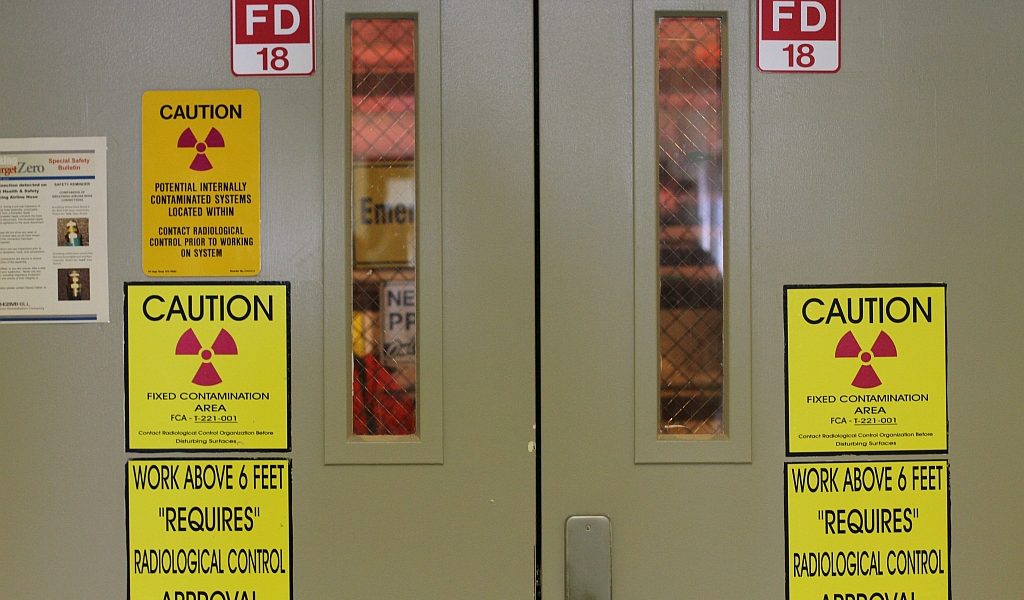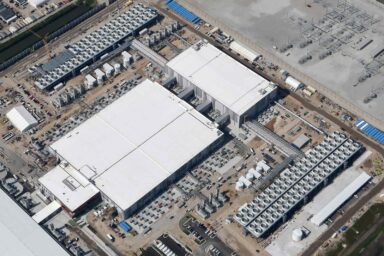Tucked away in last year’s defense bill is a measure establishing the Manhattan Project National Historical Park. It encompasses three sites crucial to America’s wartime entry to the atomic age. Is the new park a monument to death or glorious victory? Paul DeRienzo went to one of the sites to find out.
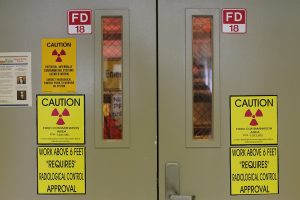
Among the items in the $600 billion National Defense Authorization Act passed by Congress last year is a measure establishing the Manhattan Project National Historical Park, which encompasses three sites central to the development of nuclear weapons.
Supporters see the park — a monument to the Manhattan Project, the super-secret wartime effort that built the atomic bombs dropped on Hiroshima and Nagasaki in August 1945 and killed 200,000 people—as a long-neglected commemoration of the bomb project. The Advisory Council on Historic Preservation reported in 2001 that the development and use of the atomic bomb during World War II was “the single most significant event of the 20th century.”
Located at Los Alamos, New Mexico; Oak Ridge, Tennessee; and Hanford, Washington, the park will be jointly run by the National Park Service and the Department of Energy. U.S. senators from the three states involved sponsored the legislation, but notably, the park itself was left unfunded.
***
Former Ohio Congressman Dennis Kucinich, a vocal opponent of commemorating the Manhattan Project, had blocked passage of the park proposal until he lost his 2012 re-election bid. Responding to the park’s supporters, who claim the monument is a celebration of technological achievement and not the bombing of civilians, Kucinich replied: “The technology which created the bomb cannot be separated from the horror which the bomb created.”
At the end of his second term, President Bill Clinton used his executive power to establish the 300-square-mile Hanford Reach National Monument in the former security zone across the Columbia River. The 50-mile stretch had been spared development as the rest of the region grew to stop spies from observing the plant in operation.
Today the Reach provides a stark, unrestricted vantage point of the Columbia River overlooking the reactors where plutonium was produced for 40 years.
Radioactive in the Desert
The ghostlike and forbidding structures stand alone against the desert, sealed up and awaiting demolition once their lingering radioactivity cools. They’ve been stripped of the miles of high-tension power lines, pump houses and other remnants of the time when the United States raced to make enough plutonium for bombs.
Hanford was a small farm town until 1943, when the United States Army forced local farmers and indigenous people to sell their land for a secret project. A year later, the first structure, called the B-Reactor, was up and running, with a workforce of 50,000 dedicated to manufacturing a single product: plutonium.
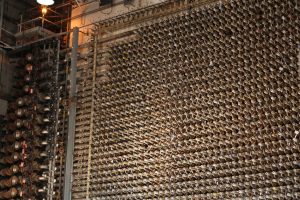
The results were successful, but with a poisonous side effect. This highly radioactive man-made element has a propensity for “fission” –splitting apart in a reaction that releases vast amounts of energy. In the course of four decades of plutonium production billions of gallons of radioactive waste were created at Hanford and discharged into the environment.
Until 1971, Hanford dumped the radioactive water used for cooling its reactors directly into the Columbia River. That pushed radiation 200 miles down the Columbia to the Pacific Ocean where the contamination washed up on the beaches of Oregon, according to a 1994 report by a government contractor, the Battelle Pacific Northwest National Laboratory.
***
The mess has already cost $40 billion to clean up over the past four decades, and another $100 billion and 40 years is needed to finish the work. Fifty-three million gallons of waste from the plutonium extraction process are stored in 177 underground tanks. Millions of gallons more were dumped into trenches or down wells hundreds of feet into the earth, while smoke stacks vented toxins into the air.
In 1986, a catastrophic explosion at the Soviet Union’s Chernobyl nuclear power plant spread radiation around the globe and raised the specter of an accident at Hanford. As questions about Hanford mounted, citizen groups formed and turned up pressure on the U.S. government to release classified information about the site.
The Department of Energy eventually turned over 19,000 declassified documents that informed an exposé penned by newspaper reporter Karen Dorn Steele. Her reports inspired a group of activists who became known as the “downwinders”–mostly descendants of the technicians and scientists who had worked at Hanford. Some downwinders, such as Trisha Pritikin, wear the “Hanford necklace,” a thin scar across the throat marking where their thyroid glands were surgically removed.
Pritikin told WhoWhatWhy that she first made a connection between thyroid cancer and the Hanford plant in 1986, when she read about the Green Run, a secret experiment in the late 1940s that purposely released radioactive iodine into the environment. The exact purpose of the iodine release remains a mystery, although historians believe the experiment was designed to test special equipment to spy on Soviet nuclear tests.
“Oh My God! My Dad Worked There”
The radioactive isotope iodine-131 can be absorbed by the thyroid glands of mammals, which have an affinity for iodine. The thyroid is then bombarded by particles emitted by the radioactive iodine which can cause cancer. Pritikin thought: “Oh my god! My dad worked there.” Her father had died of thyroid cancer in 1996; 13 years later, Pritikin’s own thyroid was removed after doctors found precancerous nodules.
The Hanford Health Information Network, a new public organization, worked with the Washington State Department of Health to gather radiation exposure data and publicized the health effects to residents who had lived in the shadow of the plant. After the groups pressured the DOE, The Centers for Disease Control (CDC) eventually launched a project to estimate how much of a radiation dose the public received.
The CDC report was a blow to the downwinders’ case, stating: “The risks of thyroid disease in study participants were about the same…” no matter what dose of radiation they received between 1944-57, the peak years of Hanford operations. The CDC report didn’t stop hundreds of cases from being filed against the government.
In 2012, the government offered Hanford downwinders a puny sum of about $6,700 each to drop their claims—compensation that would have to be funded by taxpayers. That’s because of an agreement reached in the early days of the Manhattan Project, which indemnified government contractors involved in nuclear research and weapons production.
Currently so-called bellwether cases are winding through the courts; Pritikin’s claims are being argued in initial tests of each side’s legal arguments before hundreds more cases are brought to trial.
A Deadly Brew
While the legal battle grinds on, the mess on the grounds is nowhere near cleaned up.
One of Hanford’s legacies is leaky single-walled waste tanks from the 1940s—each holding a brew said to contain virtually every known radioactive element and toxic chemical. A model of one is on display at the Columbia River Exhibition of Science and Technology Museum, part of the Hanford Reach Interpretive Center.
Today, at least 67 of these tanks have leaked a minimum of one million gallons of waste. Only one has since been removed. Much of the liquid tank waste has been consolidated into 1960s-era double-shelled tanks, which have so far not leaked but whose integrity the DOE has admitted can’t be guaranteed. The waste is deadly, highly radioactive, and constantly producing explosive gases that must be vented.
On the front lines of that waste are Native American people living near the Hanford site. An independent study published in 2009 by ethnographer Deward E. Walker found that one such group, the Yakama people had an estimated 1-in-50 chance of developing cancer.
***
Russell Jim, 78, a Yakama elder and cancer survivor, said the most important issue for the tribe is “protection and respect for treaty-reserved rights,” which he asserts are violated by underground plumes of radioactive waste and toxic chemicals flowing toward the Columbia. Some plumes are just 400 yards from the river, threatening the salmon runs that sustain Yakama culture.
On the bus ride with about a dozen other tourists, a guide pointed to an ancient Yakama fishing spot on the banks of a Columbia River tributary. He recounted Yakama creation stories as we passed the long treeless mountain labeled “Rattlesnake” on official maps, but known to native people as Laliik, or the “land above the water.”
The Umatilla and Nez Perce Native American tribes live in the area, as do the Wanapum people, who reside along the river near Hanford. After a series of wars with settlers in the 1850s which displaced Native Americans on the Columbia plateau, a treaty established reservations and guaranteed the access to water, fishing, and spiritual sites.
A Manmade Mountain, in an Aura of Danger
In 2015, the nuclear tourists had little time to contemplate Native American stories, as we soon approached a manmade mountain. The imposing concrete hulk of the B-Reactor greeted the tour bus against a hazy morning sky. An imposing granite plaque at the entrance announced: “World’s First Full Scale Nuclear Reactor.” Guides boarded the bus and gave a safety speech.
The museum itself has an aura of danger. It’s a raw industrial space filled with strange objects. Facing a large room is the 36-foot-high face of the reactor with its 2,004 tubes that allowed millions of gallons of river water and tons of uranium in aluminum cans to be fed into the core of the reactor.
Throughout World War II and then the Cold War as many as 30,000 canned “slugs” of uranium were processed each week to make plutonium for thousands of nuclear weapons. After weeks of neutron irradiation, the canned uranium, now millions of times more radioactive, was ejected out of the back of the reactor and glowed an eerie blue at the bottom of the storage pool.
Sometimes cans would split open, causing delays in the process as they had to be removed remotely since humans could not come close to the deadly radiation. Much of the oozing radioactive contents of the damaged cans would then enter the cooling water to be flushed into the river.
The cans of uranium sat in the pool for weeks until the fierce initial radiation subsided. Then they were loaded onto a lead-lined railway car and brought to another structure, the T-plant, for plutonium recovery. Known as the “canyon” because of its high concrete walls and “Queen Mary” because it resembled the famous cruise ship, the structure can be seen for miles against the desert horizon.
Like a Morgue
Steve Buckingham, a 92-year old retired atomic worker with an infectious laugh, described how plutonium was recovered with minimal regard for safety. “It was wartime,” said Buckingham, who admits that “radioactive iodine was released in large brown clouds of gas as buckets of irradiated uranium were dissolved in a pool of acid.”
Passing from one cell to the next, two tons of irradiated uranium would be reduced to a nine-gallon bucket of plutonium nitrate —the rest left behind as waste.
The building had a strange odor, like a morgue. A passing worker warned us in an ominous tone not to wander too far from the tour.
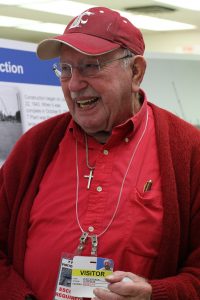
Climbing past locked doors plastered with radiation-warning symbols, we entered the galleries where the manufacturing process had been controlled. Our guide told us that an operator using cameras and remote control could “tie a knot” with the massive crane that ran the length of the facility.
With tremendous dexterity, the operators had lifted huge concrete lids capping the cells. According to Buckingham, before the advent of closed-circuit TV, the operators used mirrors to guide the crane. There was obvious pride in his voice as he recounted the skill and ingenuity of the T-Plants operators in creating this technological marvel of their day.
In January 1945, U.S. Army Lieutenant Colonel Franklin T. Matthias, Hanford’s wartime director, personally accompanied the first shipment of Hanford plutonium on a passenger train to Los Angeles. By April 1945, the scientists at Los Alamos were fashioning the plutonium into the core of Trinity, the first bomb which exploded in the New Mexico desert on July 16. On Aug. 9, 1945, the U.S. dropped the bomb code-named Fat Man on Nagasaki, causing more than 65,000 casualties with plutonium from Hanford.
The B-Reactor made plutonium until 1968. It was later joined by eight more reactors. Enough plutonium was created that by 1971, all of them were shut down, except for the ninth or N-Reactor. That nuclear plant became Hanford’s biggest and most controversial reactor because it produced electricity for the commercial market as well as plutonium. It was America’s first “dual use” reactor and a test bed for the commercial nuclear reactor industry. Sharing design similarities with Chernobyl, it was permanently shut down in 1987, a year after the disaster in Russia.
The Hanford nuclear site is expected to draw 100,000 curious visitors each year, according to Hanford boosters. By glorifying this grim moment in our past, what face is the United States showing the world—and ourselves?
